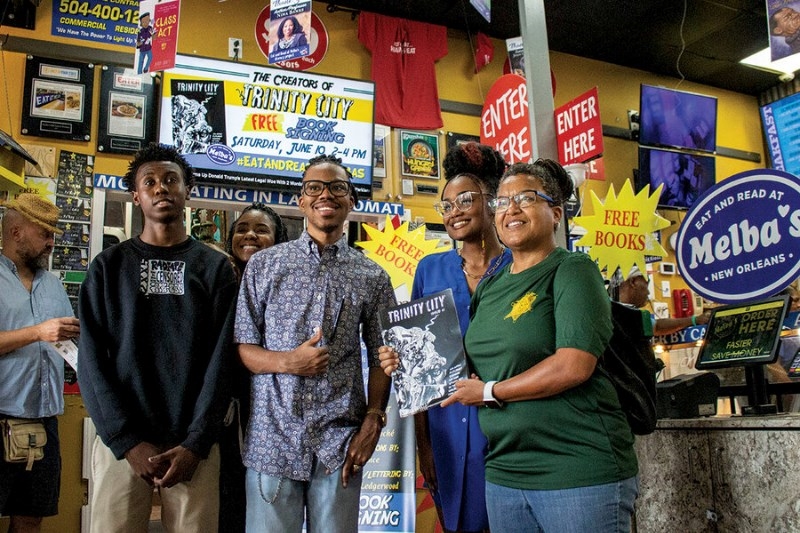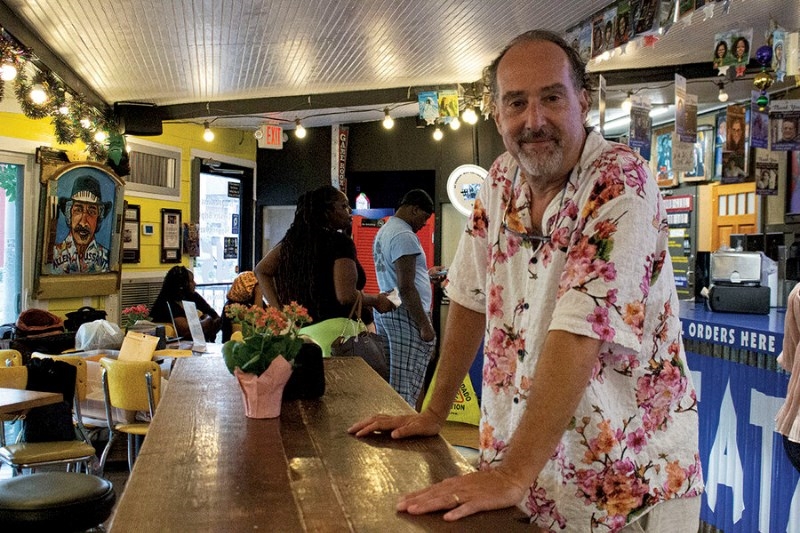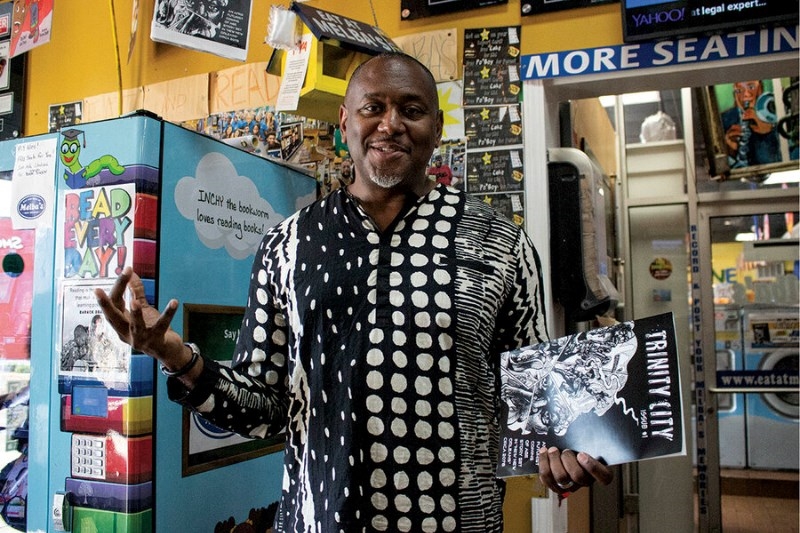REPRINTED WITH PERMISSION FROM THE CHRISTIAN SCIENCE MONITOR
 Artists (from left) Blair Augillard, Kieth Singleton, and Morgan Prevost, and mentor Sharika Mahdi pose with the newly published Trinity City comic book at an event at Melba’s restaurant June 10 in New Orleans. Millie Brigaud/The Christian Science Monitor
Artists (from left) Blair Augillard, Kieth Singleton, and Morgan Prevost, and mentor Sharika Mahdi pose with the newly published Trinity City comic book at an event at Melba’s restaurant June 10 in New Orleans. Millie Brigaud/The Christian Science Monitor
December 11, 2023|NEW ORLEANS - It started around a New Orleans kitchen table when Mat Schwarzman heard stories about his friend’s mother – and was moved. Yvonne Olivier Bechet, it turned out, was one of the city’s first female Black police officers during the turbulent 1960s and 1970s.
“She would tell me these stories about her life ... that were so remarkable they were hard to believe,”
says Mr. Schwarzman. From mediating near gun fights to organizing talent shows and police-school partnerships, Ms. Bechet, who died in 2020, was dedicated to community service within her police force and her neighborhood.
Inspired by her example, Mr. Schwarzman co-founded what’s now called Trinity City Arts, most recently known as the Black and Blue Story Project, in 2014. It’s a community of artists, educators, and activists from Louisiana focused on “imagining healthy and equitable systems of public safety,” according to its website. Its latest initiative, a three-part Afrofuturist comic series geared toward young people, was launched last spring.
“We want to produce different kinds of stories and art that will engage people in discussions about the police,” says Mr. Schwarzman. “There are people who are holding on to the past, and there are people who are frustrated with the past, who want change but don’t articulate what that change might look like.” Opening dialogue is the first step to creating something different, he says.
Polarization over policing has deepened over the years, in part because of poor communication, says Connor Powelson, a sociology Ph.D. candidate at the University of Maryland, College Park who is researching implicit bias within police forces and among civilians. But he says arts programs can complement policy, serving as a tool to build empathy, which ultimately changes behavior.
“Art is an emotional medium which conveys a narrative or situation that can allow people to associate with identities other than their own,” says Mr. Powelson.
 Millie Brigaud/The Christian Science MonitorMat Schwarzman, co-founder of Trinity City Arts, stands in Melba’s, a New Orleans eatery, during one of his nonprofit’s events June 10.
Millie Brigaud/The Christian Science MonitorMat Schwarzman, co-founder of Trinity City Arts, stands in Melba’s, a New Orleans eatery, during one of his nonprofit’s events June 10.Using theater to show other viewpoints inspired Trinity City Arts to commission its first work. Mr. Schwarzman – a “theater guy” from New Jersey – spent hours interviewing Ms. Bechet. He hired playwright Ariadne Blayde to transform those life stories into a play in 2016. Two years later, “Black and Blue” was performed for nearly a thousand spectators at Dillard University, a historically Black university in New Orleans.
According to the playwright’s website, “the play was designed to explore methods of creating better relationships between the police and the community.” In many ways, Ms. Bechet practiced community policing long before it became a buzzword. She aimed for the kind of connectedness and trust police forces are trying to foster today, says Mr. Schwarzman.
Donna Bechet-Kilbourne, one of Ms. Bechet’s four children, says the play firmly established her mother’s pioneering legacy in police work.
“[Trinity City Arts] is passing Mom’s values – of respect, generosity, stepping out of your comfort zone – to a new generation,” she says. And the play demonstrates how “police can reach out to the community, and how there are other ways of looking at the police department,” she says. “There are officers out there that want to connect with you.”
“Black and Blue” caught the attention of those who police New Orleans. Law enforcement officers made up roughly 10% of the play’s audience in 2018, according to Mr. Schwarzman.
Current New Orleans Sheriff Susan Hutson attended an online reading of the play in 2020 and immediately saw herself reflected in its story. Sheriff Hutson is the first Black woman to lead a sheriff’s office in Louisiana and the first woman to be sheriff of New Orleans.
“[Ms. Bechet] was the first of her time, and I was the first of my time. So I’m kind of living in that spirit and trying to make change in my role as Orleans Parish Sheriff,” she says. Sheriff Hutson now serves as one of Trinity City Arts’ three “team members,” along with Mr. Schwarzman, and playwright Lisa D’Amour, who guide its initiatives.
 Millie Brigaud/The Christian Science MonitorSteve Prince, an illustrator and mentor for the Trinity City comic project, hopes the effort will bring young people into the policing discussion.Engaging young people
Millie Brigaud/The Christian Science MonitorSteve Prince, an illustrator and mentor for the Trinity City comic project, hopes the effort will bring young people into the policing discussion.Engaging young peopleWhile the community dialogue around policing led by Trinity City Arts has been productive, the resurgence of the Black Lives Matter movement in 2020 encouraged Mr. Schwarzman to engage a younger audience that might brainstorm new solutions to police-community divides.
“Trinity City” is a three-part comic book series described by the group as an “Afro Futurist Coming of Age Story” set in New Orleans some 50 years in the future. Trinity City Arts commissioned three New Orleans teens who were mentored by older artists to imagine and produce the books’ artwork.
“Historically, young people have been integral to change,” says Steve Prince, one of the mentors. “We want their questions to guide the future.”
The “Trinity City” team spent weeks contemplating public safety and what a world without law enforcement might look like. They also imagined New Orleans underwater from sea-level rise.
“I found thinking about what Louisiana will look like in some years very interesting,” says Morgan Prevost, one of the teen artists.
The first book of the series is a cautionary tale – featuring flooded cities on stilts policed by robot sheriffs. “Imagining the [comic world] showed me how we can be resilient. We can continue to reside here. It’ll just require change,” Morgan says. She hopes the comic will have a similar impact on its readers.
On a warm Saturday afternoon, not long after the first issue of the three-part comic series dropped on June 1, Melba’s, a po’boy shop just off of Elysian Fields Avenue in New Orleans, buzzes back to life after a post-lunch lull. Stacks of “Trinity City” sit on a high-top table, ready to be distributed to customers at the classic New Orleans sandwich shop. As a part of Melba’s weekly Eat & Read event, customers buy po’boys and leave with a free book. In this case, the book can serve as a blueprint for a different future.
“A book is also something people can go back to,” says Dione Singleton, a school administrator and mother to Keith, one of the student artists. “As you face issues or you’re trying to make a change in your society, you can always go back to it,” she explains.
Already, Ms. Singleton has witnessed a change in Keith.
“As African American parents, my husband and I have always had conversations about social justice with Keith. But I think now working on this project and getting older, he’s starting to see things for himself ... to think about what you can do to change the society that you live in,” she says.
Related stories
Page created on 12/13/2023 5:15:44 PM
Last edited 12/13/2023 5:45:09 PM
